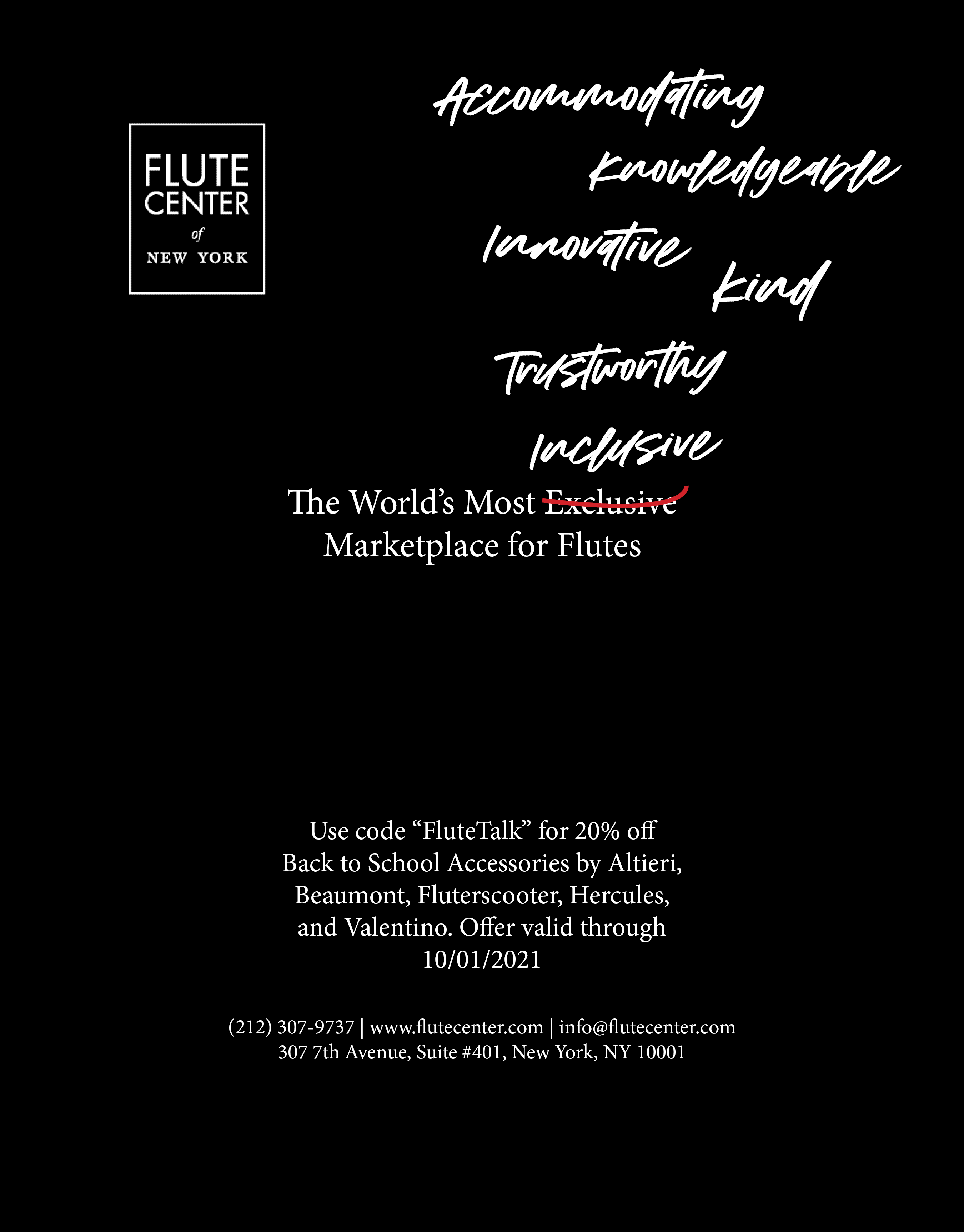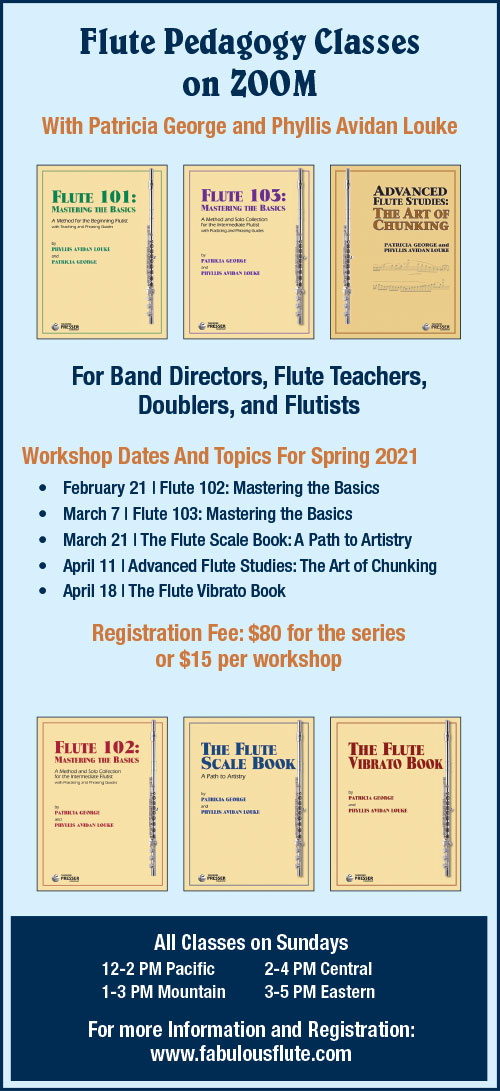During this year of staying in, many of us have had more time to practice than in the past. In these practice sessions we have gotten to know our instruments better on a different level. We have discovered things that we love and also things that we wish were improved. I decided it was time for an upgrade and wanted to share some thoughts on flute shopping. Buying a new flute is one of the most exciting events in a flutist’s life.
When I was a young student, flutists played on one of a handful of brands of student model flutes. Mine was a sturdy instrument that survived my repeated attempts of taking it apart and re-assembling it. I was sure I could make it better. Of course, it was not the flute, it was the pads. The pads were ghastly, and the only time they seated well was in the first few hours after an overhaul.
There were no step-up flutes then. The closest thing to a step-up flute was the choice made when ordering a professional model flute. You could either select a commercial model (extruded tone holes) or a professional model (soldered tone holes). At that time, I knew of only two flute makers, and both had waiting lists. One had a wait time of several months; the other was several years. When your name came up on the list, the company contacted you, and half of the payment was due before they began making your flute. The other half was due when the flute arrived. If you no longer wanted the flute, then you could sell your place in line to a friend or colleague. When the flute arrived, this was your flute. There was no testing to find the best match. There were no headjoint choices. You simply learned to play well on the flute you had. Over the next eight years I repeated this process four times before I found a flute that was a good match for me. I have played this flute off and on for 57 years.
In more normal times the best places to select an instrument is at the National Flute Association’s annual convention or at one of the regional flute fairs. With COVID-19 though, flute specialty shops have stepped up to offer free shipping both ways if a flutist wants to try flutes. This is an excellent opportunity because you can play the flute in a location that you are very familiar with. At conventions, the exhibit hall floor is quite noisy and dead sound wise. At home, you can also try out the instrument in your church, in an auditorium or another performance venue. You also have the ears of your teacher and colleagues who know your playing and can offer advice.
One of the mysteries of playing the flute is that you never hear yourself as others hear you. This means that when selecting an instrument, you must find a listener whom you trust to offer feedback. Besides a teacher, this might be a band or orchestra conductor or members of your chamber ensemble.
When purchasing a new instrument consider the various types of instruments on the market. These include: professional or handmade flutes, pre-professional flutes, mid-line, intermediate, step-up and student models.

Do Your Homework
Before beginning to shop, learn the terminology the flute makers and dealers use when making and selling their instruments. There are videos online including on YouTube that talk about the different aspects of making flutes and piccolos.
Pitch: Flutes today are made to the pitch of 440, 442, and 444. The standard in the US is 442 while in Europe the pitch is higher at 444.
Tubing: Flute making begins with the tube. Tubes may be made of silver (.925, .998), gold (19.5K, 18K, 14K, 10K, 9K. It is important to remember that the magic number is 24. If the flute is 14K, then 10 parts will be another material), platinum or fused combinations. The thickness of the tube depends largely on the material used with gold tubes being in the range of .010, .012, .014 and silver at .014, .016, .018. The most popular thickness is .016. Often the keys are made of another metal i.e., a gold flute with silver keys.
Soldered or Drawn Toneholes: Soldered tone holes take more time to make so are more expensive. Watch the videos suggested above to see the difference in the manufacture.
Inline or Offset: This refers to the alignment of the keys specifically the upper and lower G keys. It is an even toss today as to which is preferred. I have always played an inline flute and continue to do so because the flute feels smaller in my hands and is slightly less heavy. Flutists who have had hand, wrist, arm, or shoulder issues may find the offset to be more comfortable. For the keys themselves, pointed arms are standard on professional flutes.
French Model: The term French model refers to the openings in the A, G, F, E, and D keys. Most professional flutes are French models rather than with closed keys.
Pinless Mechanism: Most professional flutes made today are with the pinless mechanism or a combination of pinless and pins.
Springs: Flute makers offer the option of white gold springs, yellow gold, stainless or steel springs.
Special Options: While the C# trill used to be a special option, it has become a standard on most flutes made today. I have had flutes with and without the C# trill and find that I do like the special fingerings that are possible to improve playing certain passages; however, I am not pleased with the extra weight. I have also noticed that the C# pad often is one of the first pads to leak.
Makers have various ways of constructing what is known as the split E. Probably the more correct name for this option should be the split G since it allows the upper and lower G keys to move independently. A split E helps in slurring from the top A to the top E. Placing a donut or crescent shaped piece of metal in the lower G is another option. There are fewer moving parts on this solution so it is less likely to have adjustment issues. The donut or crescent may be added at a later time if necessary.
The D# roller on the footjoint is a lovely option to have. It certainly eases the movement of the fingers down to the lowest keys on the flute. The other option is to rub the little finger on the side of your nose to take the natural grease on the nose onto the finger. This nose grease makes moving to the lowest notes easier.
The gizmo key on the footjoint is pretty standard on most flutes today. This key is used in sensitive fingerings to play upper notes more softly and with better control.
Footjoint: Most flutes made today have a B footjoint. However, some players enjoy the C footjoint especially in the use in playing Baroque and Classic style music. Several makers make a convertible footjoint.
The Headjoint: In recent years we have seen the rise of instrument makers who specialize in making headjoints. This revolution has produced some of the best improvements to the modern flute since Boehm’s work in the middle of the 19th century. Remember it is possible to buy the body and footjoint of a flute from a maker and add the headjoint of your choice.
Headjoints are made in a variety of materials from silver to platinum with the lip plates and riser/chimney each being a different material. For the most value for your dollar, invest in the riser since that is where the blowing edge is cut. The size of the embouchure hole is an important concern too. The smaller the hole, the sweeter the tone and the more agile it is when moving from one note to another. The larger the embouchure hole the larger the sound; however, the headjoint loses some of its agility. If you can afford it, you may want to invest in one of each.
Most headjoint makers have a yearlong headjoint exchange program. Be sure and ask the details before you purchase.
Often a headjoint by another maker will be loose in the tenon of the flute. It has been my experience that a headjoint that needs a lot of sizing will ultimately play and sound differently than before it was sized. I have been told several times that sizing doesn’t make a difference, but to me, the headjoint certainly responds and sounds different than it did before sizing. Whether I am right or wrong, consider this option. If you prefer to not have the headjoint sized, there is tape that may be purchased to make the headjoint snug.
Flute Specialty Shop or Manufacturer
In the United States, there are several flute specialty shops that offer a wide selection of brands of flutes and headjoint makers. The advantage to shopping at a flute specialty store is the ability to compare models from more manufacturers. If you already know which brand you want, however, then going directly to a specific maker’s shop allows you to test more flutes by the same manufacturer.
If you are going to select a flute from one of the flute specialty shops or makers, make an appointment to try instruments rather than just showing up. Besides this being a courteous thing to do, it allows the store to have someone there to spend time with you who is knowledgeable about flutes and their construction. The shop also makes sure the inventory you are looking for is in stock and not out on approval.
Practice
Generally, when you are upgrading your instrument, there is something about your current flute that is wrong or limiting. At least a month before trying instruments, go into practice mode so your embouchure is strong and flexible; your breathing is relaxed and controlled; your articulation is clear and expressive; and your fingers are even and fluent. If there are problems when you play a new instrument, you want it to be obvious that it is the instrument’s problem and not yours.
What Do You Need?
If you primarily play with a microphone, then a low resistant headjoint may be the best choice for you. A low resistant headjoint has a quick response and an interesting range of colors, but lacks the projection to perform successfully in a large concert hall. If you are looking for projection, then select a higher resistant headjoint.
If you primarily play chamber music in a small, intimate location, then there is a flute for this setting too. Most of us do not have the luxury to have one flute for chamber music, another for large concert halls and another when playing with a microphone, so we compromise and select a flute that fulfills as many of our desires as possible. Remember that every flute will have a flaw someplace. It may be one of tuning, timbre or dynamic control of a certain note, or the way the flute responds when slurring an interval. Your goal is to choose a flute with the fewest flaws to work around.
What to Play
Harmonics: Since the flute scale is based on the overtone series, play several harmonics to explore how the flute overblows. Start by playing three harmonics on a first octave F, F# and Bb. For the Bb, use both the long fingering (TH, 1000/1004) and the Thumb Bb fingering. Listen carefully for the quality of the sound of the third partial.
Scale: Play a slow, two-octave F major scale ascending and descending. Do not adjust for pitch problems because the goal is to discover what the flute will do, not what you can do on the flute. Listen for a homogeneous sound throughout the range. Choose a flute where you have to make few adjustments to play in tune. Use a tuner throughout the flute audition process. If you are selecting an A=442 flute, set the tuner on A=442. Listen to the timbre of the scale as you play. If there are dull or bright notes here and there, then this is not the flute for you. Use a recording device or a friend in the selection process.
Octaves: Play slurred octaves beginning on the first octave F. Proceed chromatically up the flute. Listen for timbre and intonation. Again, use the tuner and a recording device.
Low Range Articulation: Each of us wants a flute that articulates quickly in the low range. Play four sixteenths=144 on each pitch, chromatically down from the first octave F to C. Check the clarity of the sound and the quickness of response. Repeat this exercise using contrasting dynamics.
High Range Articulation: Likewise, clarity and response of articulation in the top notes is necessary for artistic performance. Repeat the above exercise, beginning on the third octave F, ascending chromatically. Repeat this exercise using contrasting dynamics.
Tapers: Explore the tapers or the endings of the notes. The most difficult ones to do are in the third octave. Begin on the third octave D and taper or diminuendo the note over 12 counts. Repeat on each note ascending chromatically. Try to play from something to nothingness. Check the pitch with the tuner as you perform these tapers. Successful tapers require you to be in practice, which is why I suggested being in practice well before the day you try flutes. Remember you are trying the flute, not auditioning your skills.
Ghosts Tones: This exercise has the flutist finger a third-octave note. While playing the note, the flutist retains his embouchure position, but changes the air speed to produce the lower partials. While doing this exercise with many of my students, I realized that the quality of the tone on the lower partial affects the quality of tone of the fingered note. If the lower partial note is airy and unfocused, then the fingered note was generally quite good. However, if the lower partial note was clear and focused, then the fingered note was poor. When doing this exercise pay particular attention to the pitches of Ab, F# and E. The goal is to find a flute where all the lower partials are fuzzy and unfocused. This means the fingered notes will be terrific.
Note-Connections – Intervals: Play the third and sixth exercises slurred. (See Patricia George’s Extras.) Few flutes play fast thirds easily in the top octave. Most makers do not have the personal flute technique to execute the technical questions this exercise asks; so, do not realize their flutes perform poorly in this task. However, if you are going to have agility in the third octave, the ability to play fast, slurred thirds are a must. The instrument should not hold you back.
Playing slow intervals is also important to learn how the response of the instrument is. Be sure there are no “wolfs” in the interval. Most flutes with the old scale had a wolf from the third-octave A to the third-octave E. Many of the new flutes no longer have a wolf on these notes, but do have a wolf on the third-octave G# to E when slurring. The weight of the crown affects the wolf, so if you like everything about the flute except this one wolf, experiment by playing with a different crown. Be careful though, as a heavier crown can make the flute’s overall pitch flat and the tone dull. It is all a compromise. When playing the slow intervals (4ths, 5ths and 6ths), practice making a diminuendo into the second note, followed by a taper.
Excerpts: If the flute checks out through these exercises, it is time to begin playing your favorite excerpts. Have you noticed that most flutists start with the excerpts first and then may never proceed to asking the really basic questions of how a flute overblows, responds in articulated passages, and allows beautiful note connections and tapers? Testing flutes takes time and effort. Since this may be one of the largest purchases of your life, take the time to do it well.
Repertoire: Play something from each style period and determine if you are pleased with how the flute changes color from early music to Romantic music and contemporary. Finish the session playing something you love.
Bottom Line
Look at the construction of the flute. It is also an object of art, and the workmanship should echo that of a fine piece of jewelry. There should be no solder smudges or scratches. Many craftsmen have specially designed tools to allow you to look at the construction of the soldering of the lip plate onto the headjoint tube.
If money is not an object, then you may want all the bells and whistles; but if you are on a budget, decide what extras are actually needed. The one upgrade that offers the most improvement is in the choice of the material for the riser or chimney in the headjoint. Most makers offer silver, gold, and platinum. If funds are limited, consider a pre-owned instrument.
If the flute checks out, then ask, does this flute make me feel creative? If it is not an instrument that you can hardly wait to play, then it may not be the flute for you. I wish we could try flutes without knowing what the flute was made of as too many of my students have “gold on the brain” and have not chosen instruments that actually played very well.
If there is one thing to be learned from the COVID-19 pandemic, it is to consider resale value of the flute. So many flutists purchased flutes on credit, and then when underemployed, as many have been in the last year, find themselves with a flute that is not easily sold. Several college students have told me that their newly purchased flute is the “flute of their lifetime.” I cringe when I hear this because at their age, they are just beginning to find their flute voice. It takes years to master your voice and individuality, so more than likely, in just a few years they will realize that a different flute would match their current playing style. Most teachers suggest high school and college-aged students buy a well-made silver professional model flute. Then as their playing grows, upgrade to another headjoint. Then once established in a career, this instrument becomes a backup flute, and the flutist then purchases the instrument of their dreams.








